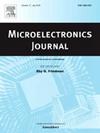Machine-learning-assisted EEHEMT compact modeling of GaN HEMTs
IF 1.9
3区 工程技术
Q3 ENGINEERING, ELECTRICAL & ELECTRONIC
引用次数: 0
Abstract
We present a machine learning approach that enhances the EEHEMT model for predicting current–voltage (I–V) characteristics of AlGaN/GaN high electron mobility transistors (HEMTs), focusing on the normalized transconductance-to-current characteristic . Instead of replacing model equations, an artificial neural network (ANN) is used to predict key parameters governing the EEHEMT model’s piecewise segments, enabling segmentation adaptive to device geometries and bias conditions. To enhance the accuracy and continuity of first-order derivative of drain current () while maintaining physically reasonable model behavior, we employ a physics-guided hybrid loss function that combines current fitting error, fitting error, a smoothness regularization term on , and a monotonic constraint on the breakpoints. The ANN-assisted EEHEMT accurately predicts device characteristics and key metrics such as , , and . This approach mitigates derivative discontinuities in , preserves model interpretability, and enhances generalization across device geometries. Notably, it accurately predicts , offering valuable insights into GaN HEMT behavior and enabling efficient, design-oriented device optimization.
GaN hemt的机器学习辅助EEHEMT紧凑建模
我们提出了一种机器学习方法,增强了用于预测AlGaN/GaN高电子迁移率晶体管(hemt)电流-电压(I-V)特性的EEHEMT模型,重点关注归一化跨导-电流特性gm/ID。该方法不需要替换模型方程,而是使用人工神经网络(ANN)来预测控制EEHEMT模型分段的关键参数,从而使分段能够适应器件几何形状和偏置条件。为了提高漏极电流(gx=∂I/∂Vx)一阶导数的准确性和连续性,同时保持物理上合理的模型行为,我们采用了一个物理引导的混合损失函数,该函数结合了电流拟合误差、gx拟合误差、gx上的平滑正则化项和断点上的单调约束。人工神经网络辅助EEHEMT准确预测设备特性和关键指标,如Vth、Ron和Idmax。这种方法减轻了gx中的导数不连续,保持了模型的可解释性,并增强了跨器件几何形状的泛化。值得注意的是,它可以准确预测gm/ID,为GaN HEMT行为提供有价值的见解,并实现高效、面向设计的器件优化。
本文章由计算机程序翻译,如有差异,请以英文原文为准。
求助全文
约1分钟内获得全文
求助全文
来源期刊

Microelectronics Journal
工程技术-工程:电子与电气
CiteScore
4.00
自引率
27.30%
发文量
222
审稿时长
43 days
期刊介绍:
Published since 1969, the Microelectronics Journal is an international forum for the dissemination of research and applications of microelectronic systems, circuits, and emerging technologies. Papers published in the Microelectronics Journal have undergone peer review to ensure originality, relevance, and timeliness. The journal thus provides a worldwide, regular, and comprehensive update on microelectronic circuits and systems.
The Microelectronics Journal invites papers describing significant research and applications in all of the areas listed below. Comprehensive review/survey papers covering recent developments will also be considered. The Microelectronics Journal covers circuits and systems. This topic includes but is not limited to: Analog, digital, mixed, and RF circuits and related design methodologies; Logic, architectural, and system level synthesis; Testing, design for testability, built-in self-test; Area, power, and thermal analysis and design; Mixed-domain simulation and design; Embedded systems; Non-von Neumann computing and related technologies and circuits; Design and test of high complexity systems integration; SoC, NoC, SIP, and NIP design and test; 3-D integration design and analysis; Emerging device technologies and circuits, such as FinFETs, SETs, spintronics, SFQ, MTJ, etc.
Application aspects such as signal and image processing including circuits for cryptography, sensors, and actuators including sensor networks, reliability and quality issues, and economic models are also welcome.
 求助内容:
求助内容: 应助结果提醒方式:
应助结果提醒方式:


